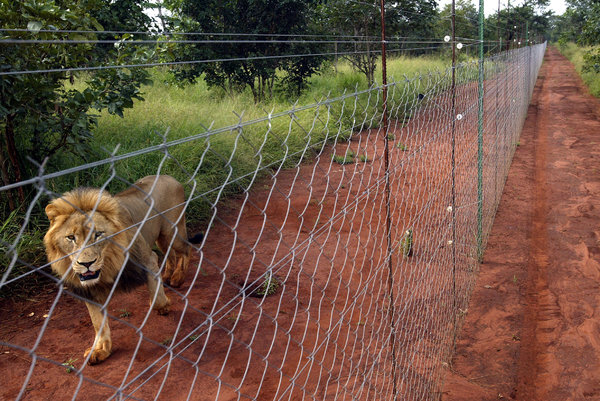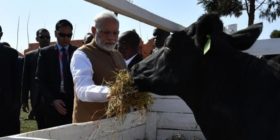A male lion walking near an electrified fence at the Sanwild Animal Sanctuary in South Africa. A new research paper suggests that fencing in Africa’s lions may be the best way to protect them.
After 35 years of field research in the Serengeti plains, Craig Packer, director of the Lion Research Center at the University of Minnesota, has lost all patience with the romance of African wilderness. Fences, he says, are the only way to stop the precipitous and continuing decline in the number of African lions.
“Reality has to intrude,” he said. “Do you want to know the two most hated species in Africa, by a mile? Elephants and lions.” They destroy crops and livestock, he said, and sometimes, in the case of lions, actually eat people.
Dr. Packer’s goal is to save lions. Fencing them in, away from people and livestock, is the best way to do that, he believes, both for conservation and economics. He made that argument in a paper this month in Ecology Letters, along with 57 co-authors, including most of the top lion scientists and conservationists.
The paper lays out the value of fences in clear terms, although it stops short of endorsing fencing as the only sensible option. That is Dr. Packer’s own view. With a growing human population whose rights must be respected, he says, open and free co-existence with lions is not practical, nor is it fair to the humans who have to live with the big cats.
In conversation, Dr. Packer goes beyond the measured scientific prose of the paper, venting his frustration with the fantasy often offered to tourists of a free and unfettered African wilderness. “That’s 130 years ago,” he said. “I’m just trying to push people to admit the obvious. Let’s get real here.”
Lions in Africa have lost 75 percent of their range in the last 100 years, problems between people and lions have increased, and some populations suffer from genetic isolation. Panthera, a conservationist organization devoted to big cats, estimates that there are 30,000 lions in Africa today, down from 200,000 lions 100 years ago.
Some populations are doing well, like those in the Serengeti, which is not fenced, and those in large and small reserves in South Africa.
Using surveys from 42 sites in 11 countries in Africa, the authors of the paper in Ecology Letters concluded that without fencing, it would cost $2,000 a square kilometer, or less than half a square mile, annually to keep lions at 50 percent of their potential numbers. With fencing, the cost would be $500 a year to maintain 80 percent of their potential numbers.
Some of the preserves in South Africa are vast. Kruger National Park covers 7,500 square miles, an area larger than Connecticut and Rhode Island together.
Fencing itself is expensive, costing about $3,000 a kilometer, or six-tenths of a mile, to install. But without it, the paper concludes, almost half of the unfenced lion populations could come close to extinction in the next few decades.
Not all the authors see fencing as the only solution, although they recognize its value in many situations. Luke Hunter, the president of Panthera, and a co-author, said, “it’s clear that fencing does help lion conservation.” And, he said, people outside of Africa underestimate the difficulties posed by lions, which, he said, are “really, really difficult to live with if you’re a subsistence human population that depends on livestock.”
But, Dr. Hunter said, he had reservations about wholesale fencing. He said the authors had not been able to evaluate the effectiveness of the various efforts to resolve conflicts between lions and people, including livestock management and other issues, because there had simply not been enough of them. Also, he said, “there are still huge parts of wilderness in Africa,” where conflicts between humans and lions are not yet a problem. And if Africa’s burgeoning human population concentrates in cities rather than fanning out through wilderness areas, he said, there might be fewer problems between the species, diminishing the need for fencing.
Both Dr. Packer and Dr. Hunter believe that developed countries in the West, and institutions like the World Bank, must contribute more to protect Africa’s resources, which can help generate economic development through tourism.
Many African countries will need help. Even if they choose fencing as the most cost effective solution, some can’t afford it on their own. Fencing the Selous Game Reserve in Tanzania, for instance, would cost $30 million, Dr. Packer said. The area must then be managed. At about 17,000 square miles, the yearly bill to manage the lion population there, fenced, would be $22 million. And that is not the only lion area in Tanzania.
The needs of the human population must be recognized, Dr. Packer said, and fencing helps to do that.






Leave a reply